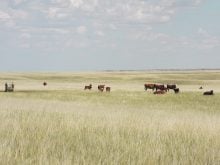Adequate colostrum intake is essential to get a calf off to a good start.
Newborn calves are born with virtually no immunity of their own. The placenta of the cow does not allow antibodies to pass from the mother to the calf during pregnancy. This means that the calf must receive its initial immunity from the antibody-rich colostrum, or first milk of the cow.
This initial immunity provides protective antibodies against many diseases that affect newborn calves, such as calf scours, navel abscesses, arthritis and pneumonia.
Read Also

Saskatchewan dairy farm breeds international champion
A Saskatchewan bred cow made history at the 2025 World Dairy Expo in Madison, Wisconsin, when she was named grand champion in the five-year-old Holstein class.
The components of colostrum are probably more similar to blood than milk. It not only contains important antibodies against infectious diseases, but is also rich in fat, energy, vitamins A and D, blood cells and various growth factors.
However, producers seldom recognize that colostrum can also transmit infectious diseases to the newborn calf. Bringing colostrum onto one farm from another farm would have the same risks as bringing in new animals. It should be considered as a significant biosecurity risk.
Obviously, we want calves to get up and suckle on their own and avoid intervening where possible, but the first meal of colostrum is so vital that we must identify those calves unlikely to suckle on their own and intervene in the first six hours of life.
Calves born in difficult births and those that are abandoned, poorly mothered or facing hypothermia are most at risk of not receiving enough colostrum. As well, cows with pendulous udders and large teats can make suckling difficult for even vigorous newborn calves.
Calves in these risk categories or calves that don’t suckle for other reasons should be given supplemental colostrum within the first six hours of life.
There are a number of options for providing supplemental colostrum. We can milk the dam and use her colostrum or use colostrum that we’ve saved from another cow in our herd or freeze-dried colostrum substitutes.
If using a colostrum substitute, producers must guard against a number of diseases that can be transmitted through colostrum. Purchasing colostrum from another farm creates a significant biosecurity risk that could introduce a number of infectious diseases into your herd.
Diseases such as Johne’s disease (Mycobacterium avium paratuberculosis), salmonella, mycoplasma bovis arthritis and bovine leukosis virus can all be transmitted through infected colostrum. A number of these diseases are found at a higher prevalence in dairy herds and could be transmitted to your herd through purchased colostrum. All of these specific diseases can be difficult to control if established in your herd.
In addition to the biosecurity risk, purchased colostrum may sometimes be of poorer quality in terms of the amount of antibodies it contains and the calf may not receive adequate immunity.
When intervention is necessary, the preferred option is to milk the dam and use its own colostrum to feed the calf. If the cow or heifer lacks an adequate volume of colostrum or can’t be milked, then we must rely on other sources of colostrum. The second best of the preferred options is to use colostrum collected from another cow within your own herd.
When possible, collect colostrum from cows that lose their calves or that have an abundance of colostrum and need to be milked. Colostrum can be kept in the refrigerator for seven to 10 days to be used for other newborns. Extra colostrum can also be kept frozen for up to a year. Frozen colostrum should be thawed in a warm water bath gradually and not be heated to a high temperature because the antibodies can be destroyed by high heat.
An additional option is to use a freeze-dried colostrum substitute, especially when milking the dam is not possible. Read the label on these products because they are not all the same in terms of immunoglobulin levels. A veterinarian can help to recommend a product.
They are also useful for supplementing a calf when the dam does not have an adequate supply of colostrum.














